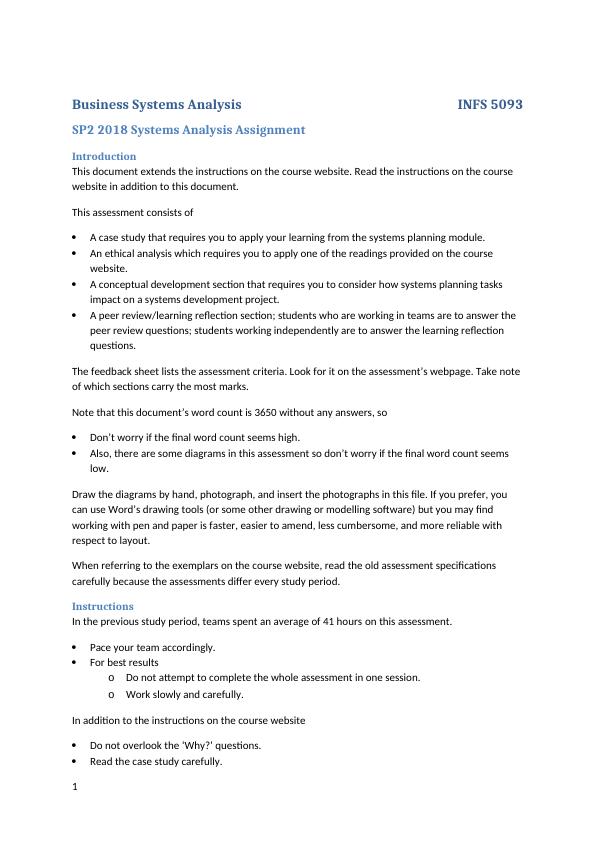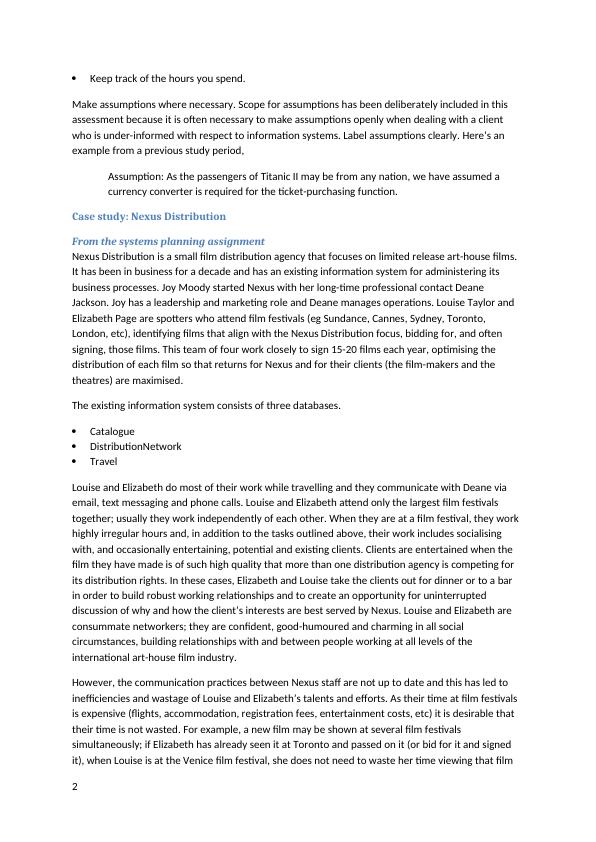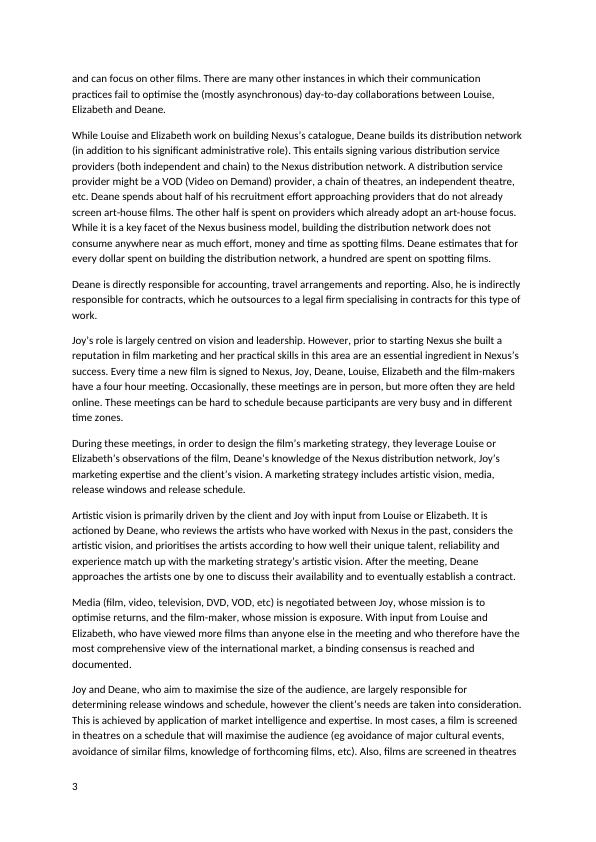Ask a question from expert
Business Systems Analysis (pdf)
16 Pages5245 Words203 Views
Added on 2021-06-17
Business Systems Analysis (pdf)
Added on 2021-06-17
BookmarkShareRelated Documents
Business Systems AnalysisINFS 5093SP2 2018 Systems Analysis AssignmentIntroduction This document extends the instructions on the course website. Read the instructions on the course website in addition to this document.This assessment consists of A case study that requires you to apply your learning from the systems planning module. An ethical analysis which requires you to apply one of the readings provided on the course website.A conceptual development section that requires you to consider how systems planning tasks impact on a systems development project.A peer review/learning reflection section; students who are working in teams are to answer the peer review questions; students working independently are to answer the learning reflection questions.The feedback sheet lists the assessment criteria. Look for it on the assessment’s webpage. Take noteof which sections carry the most marks.Note that this document’s word count is 3650 without any answers, so Don’t worry if the final word count seems high.Also, there are some diagrams in this assessment so don’t worry if the final word count seems low.Draw the diagrams by hand, photograph, and insert the photographs in this file. If you prefer, you can use Word’s drawing tools (or some other drawing or modelling software) but you may find working with pen and paper is faster, easier to amend, less cumbersome, and more reliable with respect to layout.When referring to the exemplars on the course website, read the old assessment specifications carefully because the assessments differ every study period.InstructionsIn the previous study period, teams spent an average of 41 hours on this assessment.Pace your team accordingly.For best resultsoDo not attempt to complete the whole assessment in one session.oWork slowly and carefully.In addition to the instructions on the course websiteDo not overlook the ‘Why?’ questions.Read the case study carefully.1

Keep track of the hours you spend.Make assumptions where necessary. Scope for assumptions has been deliberately included in this assessment because it is often necessary to make assumptions openly when dealing with a client who is under-informed with respect to information systems. Label assumptions clearly. Here’s an example from a previous study period, Assumption: As the passengers of Titanic II may be from any nation, we have assumed a currency converter is required for the ticket-purchasing function.Case study: Nexus DistributionFrom the systems planning assignmentNexus Distribution is a small film distribution agency that focuses on limited release art-house films. It has been in business for a decade and has an existing information system for administering its business processes. Joy Moody started Nexus with her long-time professional contact Deane Jackson. Joy has a leadership and marketing role and Deane manages operations. Louise Taylor and Elizabeth Page are spotters who attend film festivals (eg Sundance, Cannes, Sydney, Toronto, London, etc), identifying films that align with the Nexus Distribution focus, bidding for, and often signing, those films. This team of four work closely to sign 15-20 films each year, optimising the distribution of each film so that returns for Nexus and for their clients (the film-makers and the theatres) are maximised.The existing information system consists of three databases.CatalogueDistributionNetworkTravelLouise and Elizabeth do most of their work while travelling and they communicate with Deane via email, text messaging and phone calls. Louise and Elizabeth attend only the largest film festivals together; usually they work independently of each other. When they are at a film festival, they work highly irregular hours and, in addition to the tasks outlined above, their work includes socialising with, and occasionally entertaining, potential and existing clients. Clients are entertained when the film they have made is of such high quality that more than one distribution agency is competing for its distribution rights. In these cases, Elizabeth and Louise take the clients out for dinner or to a bar in order to build robust working relationships and to create an opportunity for uninterrupted discussion of why and how the client’s interests are best served by Nexus. Louise and Elizabeth are consummate networkers; they are confident, good-humoured and charming in all social circumstances, building relationships with and between people working at all levels of the international art-house film industry.However, the communication practices between Nexus staff are not up to date and this has led to inefficiencies and wastage of Louise and Elizabeth’s talents and efforts. As their time at film festivals is expensive (flights, accommodation, registration fees, entertainment costs, etc) it is desirable that their time is not wasted. For example, a new film may be shown at several film festivals simultaneously; if Elizabeth has already seen it at Toronto and passed on it (or bid for it and signed it), when Louise is at the Venice film festival, she does not need to waste her time viewing that film 2

and can focus on other films. There are many other instances in which their communication practices fail to optimise the (mostly asynchronous) day-to-day collaborations between Louise, Elizabeth and Deane.While Louise and Elizabeth work on building Nexus’s catalogue, Deane builds its distribution network(in addition to his significant administrative role). This entails signing various distribution service providers (both independent and chain) to the Nexus distribution network. A distribution service provider might be a VOD (Video on Demand) provider, a chain of theatres, an independent theatre, etc. Deane spends about half of his recruitment effort approaching providers that do not already screen art-house films. The other half is spent on providers which already adopt an art-house focus. While it is a key facet of the Nexus business model, building the distribution network does not consume anywhere near as much effort, money and time as spotting films. Deane estimates that for every dollar spent on building the distribution network, a hundred are spent on spotting films.Deane is directly responsible for accounting, travel arrangements and reporting. Also, he is indirectlyresponsible for contracts, which he outsources to a legal firm specialising in contracts for this type ofwork.Joy’s role is largely centred on vision and leadership. However, prior to starting Nexus she built a reputation in film marketing and her practical skills in this area are an essential ingredient in Nexus’s success. Every time a new film is signed to Nexus, Joy, Deane, Louise, Elizabeth and the film-makers have a four hour meeting. Occasionally, these meetings are in person, but more often they are held online. These meetings can be hard to schedule because participants are very busy and in different time zones.During these meetings, in order to design the film’s marketing strategy, they leverage Louise or Elizabeth’s observations of the film, Deane’s knowledge of the Nexus distribution network, Joy’s marketing expertise and the client’s vision. A marketing strategy includes artistic vision, media, release windows and release schedule. Artistic vision is primarily driven by the client and Joy with input from Louise or Elizabeth. It is actioned by Deane, who reviews the artists who have worked with Nexus in the past, considers the artistic vision, and prioritises the artists according to how well their unique talent, reliability and experience match up with the marketing strategy’s artistic vision. After the meeting, Deane approaches the artists one by one to discuss their availability and to eventually establish a contract.Media (film, video, television, DVD, VOD, etc) is negotiated between Joy, whose mission is to optimise returns, and the film-maker, whose mission is exposure. With input from Louise and Elizabeth, who have viewed more films than anyone else in the meeting and who therefore have the most comprehensive view of the international market, a binding consensus is reached and documented.Joy and Deane, who aim to maximise the size of the audience, are largely responsible for determining release windows and schedule, however the client’s needs are taken into consideration.This is achieved by application of market intelligence and expertise. In most cases, a film is screened in theatres on a schedule that will maximise the audience (eg avoidance of major cultural events, avoidance of similar films, knowledge of forthcoming films, etc). Also, films are screened in theatres 3

(primary distribution service providers) prior to being released via secondary distribution service providers (eg VOD service providers, DVD runs, etc). The duration for which the film is screened in theatres depends upon various factors (audience, the film’s performance in other markets, the agreement between Nexus and the film-makers, the agreement between Nexus and the theatres, etc). For most films, the theatrical release date is preceded by four weeks of postering and trailers, wherever possible working with the film-makers in order to leverage the social profiles of those who worked on the film (eg the actors and crew). For highly anticipated films, these four weeks may extend to six or eight and may require Deane to schedule interviews for the film-makers or actors with local media.Although the existing IS meets Nexus’s administrative needs, the ongoing daily communication problems and the difficulties of scheduling and running online meetings need to be addressed. Deane thinks Nexus needs its own app so that database updates can be done by anyone at any time and he has contacted your workplace, IT Foundry, to enquire further. You have been allocated the task of systems planning for the development of an app for Nexus. Also, although they are very talented, experienced and respected in their fields, the entire Nexus team are inexperienced in systems analysis and design. They are confident you will come up with relevant ideas, they anticipate your suggestions and they expect you to catalyse and drive all technical aspects of the project. These clients are very much open to suggestion.New informationThe preliminary investigation you wrote up for the Nexus project enabled you to develop a basic understanding of the business context. Your scope lists captured the project’s key elements and made a positive impression on Joy, Deane, Louise and Elizabeth. They have approved the project’s progression to system analysis and you have scheduled a meeting with them. Recall: you can make assumptions in this assignment (as noted in the instructions above). Also, you can use the course forum if you have any questions.1.Prepare for this meeting. Write an agenda that includes six topics you would like to discuss with them (if you do not know what an agenda is, look it up on the internet). These topics should be derived from your planning documents and should enable your clients to talk about the things you need to know during systems analysis (eg, the data and how it is processed). Agenda 1: System requirements and its analysisAgenda 2: Organizational structure of Nexus DistributionAgenda 3: System analysis as per requirementsAgenda 4: Design of system interfacesAgenda 5: System developmentAgenda 6: System diagrams and client’s approvalAfter this meeting, the following requirements are known:4

End of preview
Want to access all the pages? Upload your documents or become a member.
Related Documents
Business Systems Analysis for Nexus Distributionlg...
|13
|4619
|414
Business Systems Analysis for Deskliblg...
|18
|5436
|418
Business Systems Analysis for Deskliblg...
|20
|6312
|463
Business Systems Analysis for Deskliblg...
|22
|7321
|317
Business Systems Analysis for Deskliblg...
|18
|6026
|418
TAEDES401 & TAEDES402 Learner Workbook - Deskliblg...
|52
|14269
|215